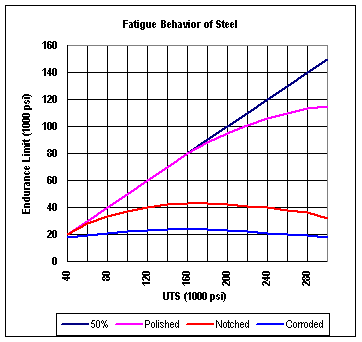- Fretting Corrosion -
One of the most insidious causes of part failure
NOTE: All our Products, Designs, and Services are SUSTAINABLE, ORGANIC, GLUTEN-FREE, CONTAIN NO GMO's, and will not upset anyone's precious FEELINGS or delicate SENSIBILITIES.
Fretting corrosion has been the cause of countless failures at the contact points of machinery components. (Click here to see several clear photos of fretting which resulted in fatigue fracture). The ASM Handbook on Fatigue and Fracture defines fretting as:
"Fretting is a special wear process that occurs at the contact area between two materials under load and subject to minute relative motion by vibration or some other force." (ref-3:9:321).
When two pieces of material that are contacting each other in an un-lubricated environment are subjected to a large cyclic loading (vibration, dynamically-changing applied load, etc.), so that small oscillatory motions occur with respect to each other, wear will occur on the mating surfaces. Examples of that type of contact include bolted flanges, riveted lap-joints, press-fits such as a gear or bearing on a shaft, and dry (unlubricated) splined components.
If the magnitude of the displacement is less than about 0.003 inches, the wear is termed "fretting".
Fretting occurs when asperities on the mating surfaces continually adhere to each other, then tear apart, which causes tiny particles to be pulled free from the surfaces and which leaves minute shallow pits and a powdery debris. If the debris is exposed to air, the small fragments of metal which have been boken off will oxidize, forming oxide particles which, for most engineering metals, are harder than the mated parts. These particles become trapped between the mating surfaces and cause abrasive damage and scoring. In ferrous parts, the oxide is a red, rustlike powder or sludge, which led to the term "fretting corrosion".
Briefly, the characteristics of fretting are:
- It is most serious when oxygen is present, although it can also occur in an inert gas;
- It is worst under perfectly dry conditions;
- It increases with contact load, slip amplitude, and number of oscillations;
- Soft materials generally exhibit more susceptibility to fretting than do hard materials of a similar type;
- Lubricants, particularly when used with surface treatments such as phosphating, reduce fretting damage.
It is interesting to note that there is disagreement in the reference literature on the effectiveness of lubrication. Reference 3:9:324 says: "The introduction of a lubricant into the interface can make matters worse by increasing the relative slip".
Fretting appears to be particularly aggressive in cases of disks (gears, pulleys, wheels, flywheels, bearings, hubs, etc.) which are press-fit (shrink-fit) onto shafts which are subjected to reversing bending stress, and worse yet under the added influence of vibration. The stress concentration which occurs where the shaft just meets the disk compounds the problem.
Under fretting conditions, fracture cracks can initiate at very low stresses, well below the fatigue limit of non-fretted specimens. Fretting corrosion can reduce the endurance limit of steels to as little as 18% of their original values. The greatest reduction in fatigue strength occurs when the fretting process AND cyclic stressing are applied simultaneously. The fact that fatigue cracks can form under low nominal cyclic stresses in areas where fretting is occurring is dramatically illustrated by the well-known low fatigue limit of a shaft having a pressed-on bearing.(ref-3:8:365)

This plot illustrates the dramatic effect that fretting has on the fatigue life of steels. The line titled "Corroded" mirrors the shape of the "notched" curve, but is much lower. The corroded curve shows that, for a badly corroded surface (fretting, oxidation, galvanic, etc.) the endurance limit of the material starts at around 20 ksi for materials of 40 ksi UTS (50%), increases to about 25 ksi for materials between 140 and 200 ksi UTS, then decreases back toward 20 ksi as the material UTS increases above 200 ksi.
Prevention of fretting fatigue in the design process is essential. Although there is ample descriptive material on the mechanism and examples of fretting, there is limited availability of generalized techniques or modeling methodology for the prediction of crack initiation due to fretting. Testing is usually required to find and validate a solution to a fretting problem.
This information has been excerpted and condensed from four different reference works: ref-2:3, ref-2:5, ref-3:8, and ref-3:9.

